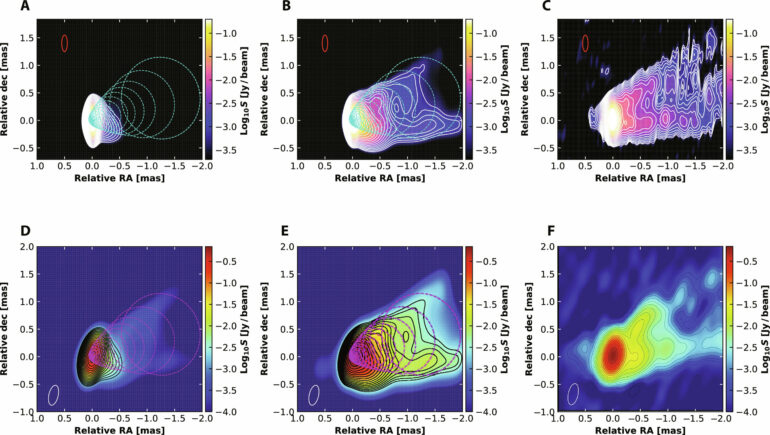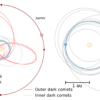An international team led by Dr. Yuan Feng from Shanghai Astronomical Observatory of the Chinese Academy of Sciences has investigated the validity of the two main models of black hole jets by calculating the radiation predicted by these models and comparing it with observations of the M87 jet, and found that the “extraction of black hole rotational energy” model accurately predicted the observed jets, while the “extraction of accretion disk rotational energy” model struggled to explain the observational results.
The radiating electrons are accelerated by magnetic reconnection in black hole jets, which is likely driven by “magnetic eruptions” in the accretion disk. The study was published in Science Advances.
Black holes are extraordinarily peculiar celestial bodies in the universe, possessing an immensely powerful gravitational force that even light cannot escape within their radius, known as the event horizon.
However, more than a century ago, observations revealed that just beyond the black hole’s event horizon, at a very close distance, the black hole could emit powerful outflows of matter and energy at speeds approaching the speed of light—known as jets. Images captured by telescopes depict these jets shooting straight outwards, much like a laser beam, extending to vast distances, with the lengths of some jets even surpassing the scale of galaxies.
How these enigmatic jets form has been a question studied for over a century by many scholars including Nobel laureate Sir Roger Penrose. Currently, there are mainly two models in this research field. One involves extracting the rotational energy of the black hole from oversized-scale magnetic fields, known as the “extraction of black hole rotational energy” model. The other one also relies on large-scale magnetic fields, but unlike the first one, it involves extracting the rotational energy of the accretion disk, termed the “extraction of accretion disk rotational energy” model.
Astronomers are attempting to address only the source of energy for the jets. Can the jets produced by these two models match the observational results regarding the morphology, width, velocity field, and polarization of the jets? Which of the two models for the formation mechanism of these jets is correct? The team led by Dr. Yuan Feng has answered these two questions.
The team used the jets from the supermassive black hole at the center of the M87 galaxy as a case. This supermassive black hole is known as the “star” of the first-ever image of a black hole captured by the Event Horizon Telescope (EHT). The team employed large-scale numerical simulation methods to solve the equations of general relativistic magnetohydrodynamics, and obtained the accretion flow around the black hole and the jets produced by the two models mentioned above.
To calculate the radiation from the jets and compare it with observations, the energy spectrum and spatial distribution of radiating electrons are crucial. The team hypothesized that electron acceleration occurred through the “magnetic reconnection” mechanism in the jets. It considered the physical mechanisms of magnetic reconnection accelerating electrons and combined the results of particle acceleration studies using kinetic theory to solve a steady-state electron energy distribution equation. It obtained the energy spectra and number densities of electrons in different regions of the jets.
Combined these with the results of numerical simulations of accretion including magnetic field strength, gas plasma temperature and velocity, the team obtained various predicted observational results by calculating the radiation transfer in the framework of general relativity, which could be compared with real observations.
The results showed that the morphology of the jets predicted by the “extraction of black hole rotational energy” model matched the observed morphology of the jets very well, and other predictions of this model such as “limb-brightening” of the jets, jet width, length, and velocity field also matched the observations very well. In contrast, the predictions of the “extraction of accretion disk rotational energy” model were inconsistent with observations.
In addition, the team analyzed the physical mechanism of magnetic reconnection, and found that the mechanism is due to “magnetic eruptions” generated by the magnetic fields in the accretion disk of the M87 black hole. These eruptions can cause strong disturbances to the magnetic field, which can propagate over long distances, leading to magnetic reconnection in the jets.
This work bridges the gap between the dynamic model of jet formation and various observational properties of jets, providing the first evidence that this well-known dynamic model addresses the energy issues of jets and explains other various observational results.
More information:
Hai Yang et al, Modeling the inner part of the jet in M87: Confronting jet morphology with theory, Science Advances (2024). DOI: 10.1126/sciadv.adn3544
Provided by
Chinese Academy of Sciences
Citation:
Modeling M87’s jet: Why do black hole jets shine and pierce the cosmic sky? (2024, March 25)



